Tailings Dam Surveillance Technology – KCB’s Experience
May 31, 2019 |
"The first rule of any technology used in a business is that automation applied to an efficient operation will magnify the efficiency. The second is that automation applied to an inefficient operation will magnify the inefficiency.” (Bill Gates)
The Fourth Industrial Revolution, which fuses the physical and digital worlds into “cyber-physical” systems, is underway. This revolution is influencing all disciplines and industries, including how the mining industry monitors their business assets including tailings dams. However, applying new technology to the surveillance of tailings dams, without critical thinking, can undermine its intended benefits or magnify an inefficient process.
What do we mean by tailings dam surveillance, and why is it important to understand how surveillance data are shared and manipulated before adding new technology to the process? "Surveillance" is an umbrella term that means different things to different people, and many people think of technology first when planning surveillance programs. An effective tailings dam surveillance program must have specified objectives and must identify and manage selected parameters that can be monitored and will add value by minimizing risk.
Designing a tailings dam surveillance program is often done without first critically thinking about its objectives or the appropriate input data and may be biased by the desire to implement leading-edge technology. A practical way to design and manage a tailings dam surveillance program is to adopt the Plan-Do-Check-Act cycle used in business for the control and continuous improvement of processes or products (i.e. the basis of quality management systems).
Here are key questions to ask using the Plan-Do-Check-Act cycle when reviewing an existing tailings dam surveillance program or designing a new one.

PLAN
- What do you need to monitor and why?
- Do you need to identify potential tailings dam failure modes? A robust and resilient design will likely require fewer credible failure modes to monitor, thus not reliant on less effective administrative controls.
- Do you need to monitor operational or compliance parameters such as water balance, pump pressures or water quality?
- Why are you monitoring?
- To optimize operations
- To develop a robust knowledge database
- To facilitate reporting activities to stakeholders, including investors and regulators
- To prevent or respond to a tailings dam failure or loss. Surveillance data may be critical for detecting a potential tailings dam failure mode.
- What are the challenges of monitoring surveillance data?
- Consider challenges related to location, climate, power supply and access to services.
- How are you going to monitor?
- This is the appropriate stage to think about technology and tools!
- How do you collect and manage the data?
- What is the appropriate frequency of readings and how are the data recorded?
- How are the data organized, stored and transmitted, and in what format?
- What do you do with the information?
- This step requires critical thinking because if the process is inefficient or inadequate, the tailings dam surveillance program will not meet its objectives.
- What is the appropriate workflow for distributing and processing the data?
- How are the data visualized and reported to facilitate correct interpretation?
- What are the thresholds for follow-up and action?
- How is the information communicated in a useable format to decision-makers?
- Who decides on actions based on established thresholds?
- How is human judgement applied to response measures?
- Is the information centralized or site-based?
- How do you respond to credible triggers in a timely manner?
- Develop contingency plans and emergency response plans based on established thresholds, also known as Trigger Action Response Plans (TARPs). TARPs need to be pre-defined and integrated into the overall surveillance system architecture.
- Instrumentation TARPs are useful in developing preventative contingency plans (i.e., preventative controls with time to act), however challenging under emergency response situations (i.e., mitigative controls – rapidly developing)
- Not all initiating events and failure modes can be monitored to provide sufficient advance warning of a potential dam break (e.g., static liquefaction, earthquake).
Case Studies
Here are a few examples of tailings dam and other engineering project surveillance programs that have successfully integrated technology.
Closed Tailings Dam
This closed tailings dam, located in remote northern British Columbia, Canada is in active care. It has ten Global Navigation Satellite System (GNSS) receivers, six prisms, a weather station, ten piezometers, five digital cameras, and two pond water level stations. The system is powered by solar panels and heavy-duty battery units. Data loggers and radio monitoring stations are linked to a Trimble T4D System. Operations, Maintenance and Surveillance Manual (OMS) threshold exceedances are sent via e-mail / text message alerts for action. (Source: Newmont Goldcorp)
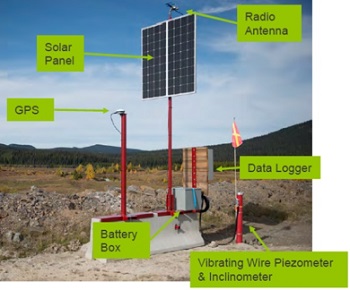
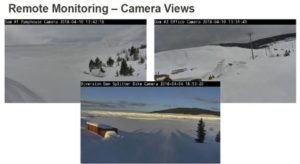
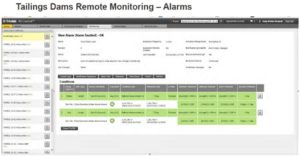
Photos: Newmont Goldcorp
Active Tailings DamThe tailings dam surveillance program at the Quellaveco copper mine in Peru is part of Anglo American’s FutureSmart MiningTM program. The surveillance program includes collecting information on the amount of water in its tailings dams, and real-time strain, deformation and seepage data via fibre-optic cable. The system also includes micro-seismic monitoring of tailings dam foundations, which checks on geological and structural features in the dams and their foundations. (Source: Mining Weekly)
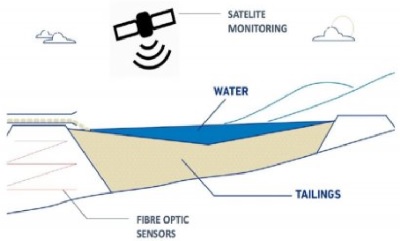 Photo: Anglo American
Photo: Anglo American
Water Supply Dam
Cleveland Dam in North Vancouver, B.C., Canada is classified as an extreme consequence dam. The dam’s safety surveillance program includes a complex network of remotely monitored instrumentation, including piezometers, inclinometers, turbidity and flow sensors, extensometers, strain gauges and pressure transducers. Continuous monitoring is integrated with a Supervisory Control and Data Acquisition (SCADA) System, Corporate Data Historian, and the water supply system control room which operates around the clock. Automated e-mail alerts and a call-out tree is triggered (including to a downstream fish hatchery) if critical thresholds are exceeded, and an appropriate response plan is activated. (Source: Metro Vancouver)
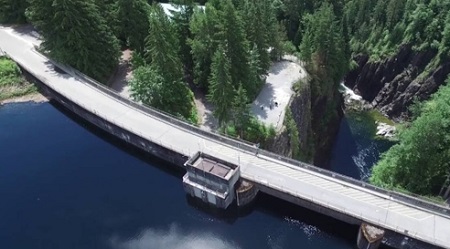
Photo: Metro Vancouver
For further information about this topic and how we can help you, please contact us at info@klohn.com or call any of our global offices.